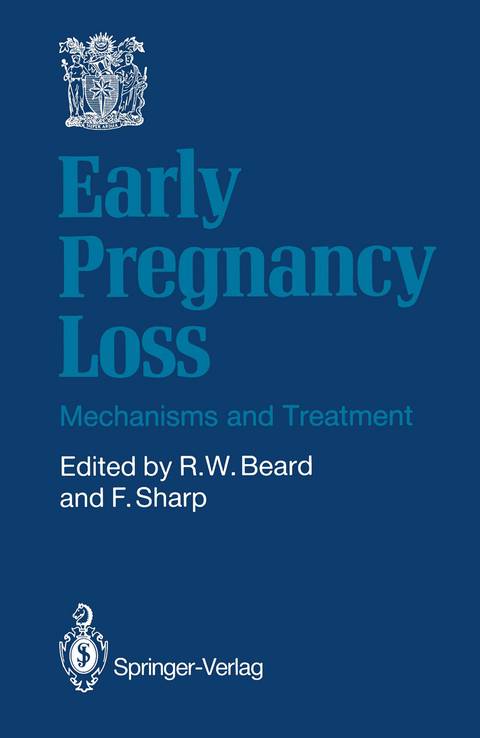
Early Pregnancy Loss
Springer London Ltd (Verlag)
978-1-4471-1660-8 (ISBN)
The first few months of any pregnancy are of supreme importance to the success of that pregnancy. This statement is so obvious as to be almost a platitude, yet it must be said that no aspect of pregnancy has been more neglected in the human than the first three months. Little is known of the morphological changes that occur at that time and our knowledge of the mechanisms that control this vital stage of pregnancy is almost non-existent. The explanation for this neglect of what is an obvious area for study is the difficulty of obtaining normal material. It is rare to have material to study from a healthy first trimester pregnancy and the study by Hertig and Rock!l) of early conception found by chance in hysterectomy speci mens must be unique. The information that we do have about early pregnancy is mostly gained from animal studies or single miscarriages in humans. Chromosomal defects are common but are not an explanation for the majority of recurrent miscarriages. Obstetricians have hypothesised many causes for this condition and have deve loped numerous metQods for treating it, but the studies have been poorly con trolled so that our understanding of the cause(s) has not advanced. Treatment of women with a history of recurrent miscarriage by paternal leuco cyte infusion (immunotherapy) may be yet another form of treatment that is hailed as a new advance only to be rejected when subject to rigorous testing.
Section 1 – The Clinical Problem.- Clinical associations of recurrent miscarriage.- The epidemiology of repeated abortion.- Discussion.- A prospective study of spontaneous abortion.- Discussion.- Clinical and immunological significance of anti-phospholipid antibodies.- Discussion.- Section 2 – Experimental Models of Early Pregnancy Failure.- Anatomical and immunological aspects of fetal death in the Mus musculus/Mus caroli model of pregnancy failure.- Discussion.- Genetic aspects of the CBA × DBA/2 and B1O × B10.A models of murine pregnancy failure and its prevention by lymphocyte immunisation.- Discussion.- Effects of feto-maternal major histocompatibility differences on litter size in pigs.- Discussion.- A non-genetic development defect in trophoblast formation in the horse: immunological aspects of a model of early abortion.- Discussion.- Section 3 – Studies of the Normal and Failing Placenta in Early Pregnancy.- Placental pathology in spontaneous miscarriage.- Discussion.- Early human trophoblast.- Discussion.- The decidua in early pregnancy.- Discussion.- Early pregnancy failure: biochemical and biophysical assessment.- Discussion.- Haemostasis and fibrinolysis in human normal placentae: possible role in early pregnancy failure.- Discussion.- Section 4 – Factors Which Maintain Pregnancy at and Immediately After Implantation.- Chairman’s introductory remarks.- Antigen expression by cells of the conceptus before, during and after implantation.- Discussion.- Host immunoregulatory mechanisms and the success of the conceptus fertilised in vivo and in vitro.- Discussion.- Interplay of oestrogens, progesterone and polypeptide growth factors at about the time of implantation.- Discussion.- Prostaglandins and other non-steroidal mediators at and immediatelyafter implantation.- Discussion.- Section 5 – Genetic Causes of Early Pregnancy Failure.- Is there a t complex in man?.- Discussion.- Immunogenetic factors influencing the survival of the fetal allograft.- Discussion.- The cytogenetics of spontaneous abortion in humans.- Discussion.- The biology of trophoblastic disease: complete and partial hydatidiform moles.- Discussion.- Section 6 – Techniques, Treatment Criteria and Outcome of Immunotherapy in Recurrent Abortion.- Chairman’s introductory remarks.- Successes and failures of immunisation for recurrent spontaneous abortion.- Discussion.- Pregnancy outcome in couples with recurrent abortions following immunological evaluation and therapy.- Discussion.- Belgian experience with repeat immunisation in recurrent spontaneous abortions.- Discussion.- Immunotherapy in recurrent spontaneous abortion: who, how, outcome.- Discussion.- Human MHC antigens and paternal leucocyte injections in recurrent spontaneous abortions.- Discussion.- Trophoblast membrane infusion (TMI) in the treatment of recurrent spontaneous abortion.- Discussion.- Section 7 – Other Methods of Treatment.- Use of cervical cerclage in patients with recurrent first trimester abortion.- Discussion.- Early recurrent pregnancy failure: treatment with human chorionic gonadotrophin.- Discussion.- Recurrent abortion: the role of psychotherapy.- Discussion.
| Zusatzinfo | XVIII, 442 p. |
|---|---|
| Verlagsort | England |
| Sprache | englisch |
| Maße | 140 x 216 mm |
| Themenwelt | Sachbuch/Ratgeber ► Gesundheit / Leben / Psychologie ► Lebenshilfe / Lebensführung |
| Medizin / Pharmazie ► Gesundheitsfachberufe ► Hebamme / Entbindungspfleger | |
| Medizin / Pharmazie ► Medizinische Fachgebiete ► Dermatologie | |
| Medizin / Pharmazie ► Medizinische Fachgebiete ► Gynäkologie / Geburtshilfe | |
| Medizin / Pharmazie ► Medizinische Fachgebiete ► Pädiatrie | |
| Studium ► Querschnittsbereiche ► Infektiologie / Immunologie | |
| ISBN-10 | 1-4471-1660-7 / 1447116607 |
| ISBN-13 | 978-1-4471-1660-8 / 9781447116608 |
| Zustand | Neuware |
| Haben Sie eine Frage zum Produkt? |
aus dem Bereich


